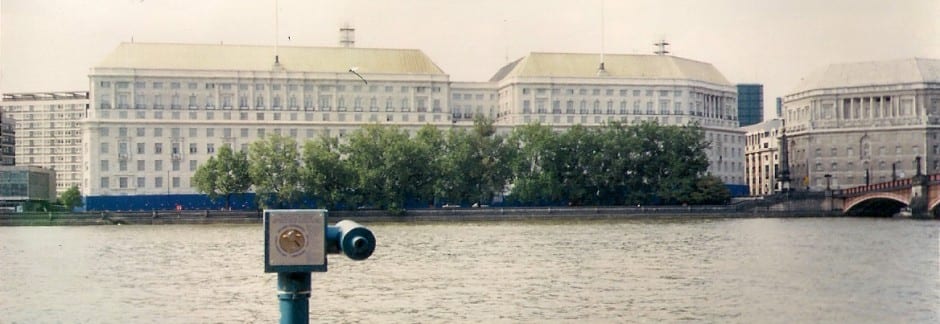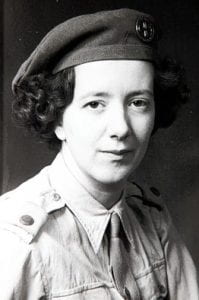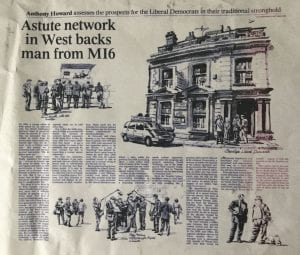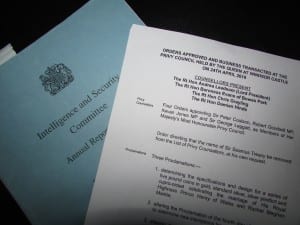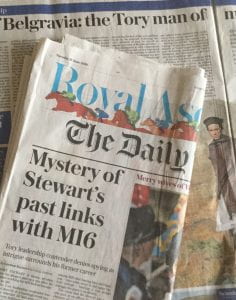 It is not clear what The Daily Telegraph hoped to achieve with its front-page claim that Conservative leadership candidate, Rory Stewart, was once a member of the Secret Intelligence Service (MI6). The claim is, at best, old news and seems unlikely to damage Stewart’s standing amongst Conservative Party members. The suggestion that Stewart, who has travelled widely and certainly worked for the Foreign Office prior to becoming an MP, also spent some time working for the intelligence services, has been circulating since he was selected as the Conservative candidate for Penrith and the Border in 2009. Stewart has denied the claim on a number of occasions but has also freely admitted that such a denial would be exactly what one would expect if he had indeed been employed by SIS.
It is not clear what The Daily Telegraph hoped to achieve with its front-page claim that Conservative leadership candidate, Rory Stewart, was once a member of the Secret Intelligence Service (MI6). The claim is, at best, old news and seems unlikely to damage Stewart’s standing amongst Conservative Party members. The suggestion that Stewart, who has travelled widely and certainly worked for the Foreign Office prior to becoming an MP, also spent some time working for the intelligence services, has been circulating since he was selected as the Conservative candidate for Penrith and the Border in 2009. Stewart has denied the claim on a number of occasions but has also freely admitted that such a denial would be exactly what one would expect if he had indeed been employed by SIS.
Moreover, if the claims are true there is nothing particularly shocking or indeed unusual about a former member of the intelligence and security agencies sitting in Parliament. Rory Stewart would not be the first former spy to sit in parliament, to take ministerial office or indeed to lead their party. The discretion of former intelligence officers means that it is difficult to determine just how many have sat on the red and green benches in the Palace of Westminster but there are a number of prominent examples dating back over the last hundred years.
In recent years greater openness about the existence of the intelligence and security agencies means that senior intelligence agency staff are now publicly named and often contribute to debates about the role of the agencies through public speeches and newspaper articles. On their retirement, some have also been offered seats in the House of Lords. The last two Directors-General of the Security Service (MI5), Eliza Manningham-Buller and Jonathan Evans, now sit in the Lords as crossbench peers from where they have contributed to debates on, amongst other things, the counter-terrorism and investigatory powers now deployed by their former employers.
While former heads of MI5 have been appointed to the crossbenches, the Conservative and Labour parties have both sought to draw expertise from the intelligence community into their ministerial teams by creating life peers. Although not a former member of the intelligence service, Pauline Neville-Jones, was chair of the Joint Intelligence Committee in the early 1990s and was made a Conservative peer by David Cameron in 2007. She was appointed as Minister for Security and Counter-Terrorism following the establishment of the coalition government in 2010. Baroness Neville-Jones’ predecessor as Security Minister was Lord West of Spithead, former Chief of Defence Intelligence, who was also made a peer 2007 and immediately joined the ministerial ranks as part of Gordon Brown’s so-called government of all the talents. The current Minister for Security, the Conservative MP, Ben Wallace, also has a background in intelligence having served as an army intelligence officer, notably in Northern Ireland.
Two long-serving SIS officers have sat on opposing sides of the House of Lords in recent years. The late Daphne Park served in the Special Operations Executive during the second world war and spent more than twenty years in SIS during the Cold War, in a range of demanding posts including Moscow, Hanoi and the Congo. Following her retirement from the service she was created a life peer by Margaret Thatcher in 1979. Opposite her on the Labour benches another career SIS officer, Baroness Meta Ramsay, served in SIS from 1969 to 1991 before acting as a special adviser on foreign affairs to the Labour leader John Smith. She was created a life peer in 1996 and also has the distinction of being the only former member of the intelligence services to have served on the parliamentary Intelligence and Security Committee which is responsible for overseeing the work of her former employer.
Perhaps the closest parallel to Rory Stewart, particularly if he does manage to become leader of the Conservative Party is the former Liberal Democrat leader, Paddy Ashdown. Like Stewart, Ashdown spent some time in the armed forces before moving on to work for the Foreign Office in what was widely assumed to be diplomatic cover for his employment by SIS. Like Stewart, Ashdown was remarkably discreet about his involvement in covert work, only occasionally alluding to it, although also in common with Stewart he seemed happy to allow others to refer to it, perhaps recognising that it might enhance his image with voters, as in this profile in The Times in the run-up to the 1997 general election.
The immediate post-war years marked perhaps the high point for former intelligence officers in Parliament, as intelligence agencies contracted at the end of the second world war and former staff sought alternative careers. Julian Amery, Conservative MP for Brighton from 1969 to 1992, had a lively wartime career with SOE in the eastern Mediterranean and was recalled by SIS in the late 1940s to help organise the abortive attempt to foment unrest in communist Albania. Christopher ‘Monty’ Woodhouse, Conservative MP for Oxford from 1959-66 and 1970 to 1974, was another old SOE hand whose skills were utilised by SIS in the Cold War. In Woodhouse’s case, working alongside the CIA to stimulate the overthrow of the Iranian leader, Mohammed Mossadeq in 1953. Airey Neave, Conservative MP for Abingdon from 1953 to 1979 and manager of Margaret Thatcher’s successful bid to lead the Conservative Party, had a distinguished wartime career in MI9 organising escape and evasion from Nazi occupied Europe, following his own escape from Colditz. Neave wrote a number of books about his wartime exploits. Dick Brooman-White, MP for Rutherglen from 1951 to 1963, worked in the Spanish section of MI5 before transferring in 1940 to Section V of SIS responsible for the Iberian peninsula, where he was ably assisted by Kim Philby.
On the Labour benches, Kenneth Younger, MP for Grimsby from 1945 to 1959, was head of section E in wartime MI5, responsible for monitoring enemy aliens in the UK. Another of the 1945 Labour intake, Christopher Mayhew, Labour MP for South Norfolk 1945 to 1950 and Woolwich East 1951- 1974, had spent the war years in SOE. As a Foreign Office Minister in the late 1940s he was instrumental in establishing the Information Research Department a body which occasionally utilised SOE tactics and personnel to conduct covert propaganda against the Soviet bloc. Niall Macdermot, MP for Lewisham North from 1957 to 1959 and Derby North from 1962 to 1970, worked in military intelligence during the second world war and in the British Control Commission in Germany in the immediate aftermath of the war.
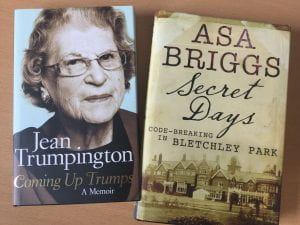 Others with wartime experience in intelligence came into Parliament later following successful careers in other fields. Baroness Trumpington and Lord Briggs both worked at Bletchley Park during the second world war. Jean Trumpington (Barker) was a leading figure in Conservative local government for many years before being rewarded with a life peerage by Margaret Thatcher in 1980. Briggs was a respected historian who held posts at the universities of Leeds and Oxford, before being made a life peer in 1976. Although both remained tight-lipped about their wartime work for most of their lives, Trumpington and Briggs both wrote about their time at Bletchley Park in recently published memoirs.
Others with wartime experience in intelligence came into Parliament later following successful careers in other fields. Baroness Trumpington and Lord Briggs both worked at Bletchley Park during the second world war. Jean Trumpington (Barker) was a leading figure in Conservative local government for many years before being rewarded with a life peerage by Margaret Thatcher in 1980. Briggs was a respected historian who held posts at the universities of Leeds and Oxford, before being made a life peer in 1976. Although both remained tight-lipped about their wartime work for most of their lives, Trumpington and Briggs both wrote about their time at Bletchley Park in recently published memoirs.
A more modest influx of intelligence officers seems to have followed the first world war but is notable for the seniority of those making the switch from the covert world to public office and for the only known case of a serving intelligence officer sitting in Parliament. Reginald ‘Blinker’ Hall was the Director of British Naval Intelligence throughout the first world war and was responsible for establishing the fabled codebreaking operation in room 40 of the Admiralty building which, amongst other things, was responsible for decrypting the Zimmerman telegram. On leaving the Admiralty, Hall was elected as Conservative MP for Liverpool West Derby from 1919 to 1923 and subsequently Eastbourne from 1925 to 1929. Unlike some other former spies, according to the official history of MI6, Hall was not above telling stories about his secret work in order to enhance his electoral prospects.
All of the individuals discussed above moved into Parliament after leaving the secret world. While some undoubtedly remained in contact with their former employers and may have occasionally been in position to pass on snippets of information, there is the only one known example of an individual who joined the intelligence services after being elected to Parliament. Sir Samuel Hoare was already a Member of Parliament when he joined the nascent SIS in 1915. Hoare, who was fluent in Russian, became head of the SIS wartime mission in Petrograd. He later moved to the British mission in Rome, where he appears to have transferred the Security Service (MI5). It is not clear when Hoare’s formal appointment with MI5 came to an end, but he went on to have a long and illustrious ministerial career and has the unique distinction of being the only Home and Foreign Secretary to have also served both in the Security Service and the Secret Intelligence Service.
It is likely that there are many more examples of former, and perhaps even serving, intelligence officers sitting in Parliament. In a number of respects Rory Stewart is something of an outsider in the Conservative leadership race. He is known for his adventurous spirit and his fondness for taking the road less travelled. If he has indeed followed a route from Eton through the intelligence services and into Parliament he is, however, on a well-trodden path.
